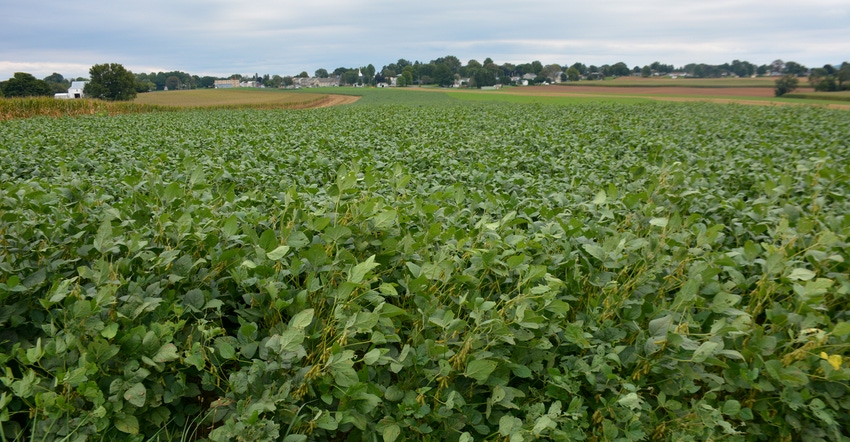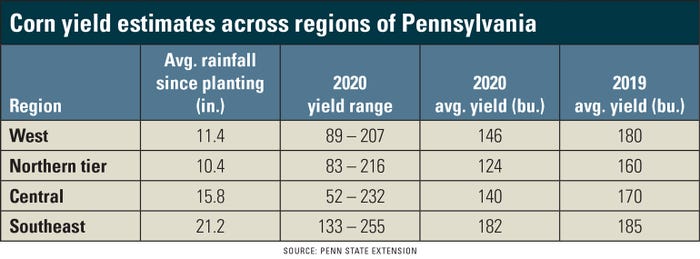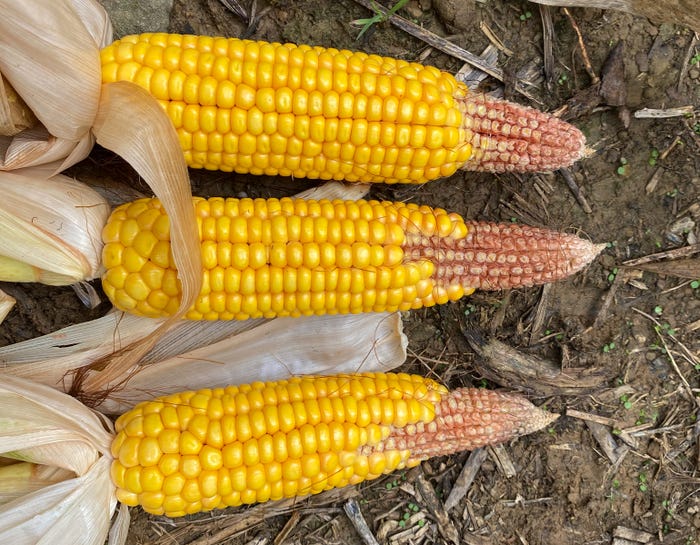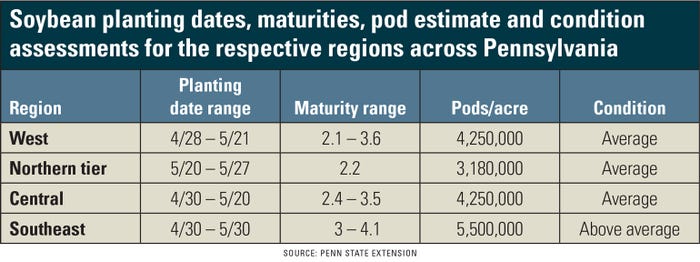September 15, 2020

Penn State Extension educators surveyed over 120 corn and soybean fields in 26 counties earlier this month as part of the annual Crop Conditions Tour, sponsored by Pennsylvania Soybean Board.
Things were everything but consistent for 2020, and in some cases, consistency was hard to find within a single field.
Corn conditions and outlook
This year’s corn crop greatly reflects the disparity in rainfall. Fields in the southeastern part of the state fared the best in terms of condition and potential yield, and early estimates of yield are similar to those of last year.

At the other end of the state were fair to poor crop conditions. Poor pollination was common across much of the western, central and northern parts of the state, reflecting moisture stress at that time.
Based on all surveyed fields, the average yield is about 153 bushels per acre, down approximately 20 bushels from last year’s tour estimate and right at the 2019 USDA end-of-year estimate. The recent Crop Production Report also estimates the average yield to be 153 bushels an acre.
Late-season drought stress was also shown in small kernel sizes, noted in Blair and Centre counties. Issues appeared earlier in the year, too, resulting in short plants and stalks that did not set an ear. In some fields, ears were low on the plant or variable across the field due to short internode length from early season drought stress.
Soils played a big part in the success and failure of crop conditions in the western and central parts of the state. Essentially, those areas saw a reversal of 2019, with low-lying and typically wet areas producing a good crop while dry areas had poor crop conditions. Those two conditions could even be seen in the same field.
The dry weather across the western, northern, and central parts of state, combined with periods of dry between rain events in the southeast, resulted in relatively low disease pressure for the 2020 corn crop. The late-season diseases of gray leaf spot and Northern corn leaf blight were present, as always.
The other issue worth nothing was lodging, with some attributed to stalk diseases and some likely due to localized weather conditions.
 POOR EARS: These poorly developed corn ears from a field in Beaver County tell the story of the 2020 growing season. While the southeast part of the state is faring well, the western part of the state is faring much worse, a result of drought conditions for much of the summer.
POOR EARS: These poorly developed corn ears from a field in Beaver County tell the story of the 2020 growing season. While the southeast part of the state is faring well, the western part of the state is faring much worse, a result of drought conditions for much of the summer.

Another common issue seen this year was red kernel streak, which may be a problem for those wanting to get certain premiums. Otherwise, it does not affect the nutritional value of corn. Corn earworms were spotty with few other major insect issues noted.
Grassy weeds, such as foxtail, were one of the more frequently noted field issues.
Resilient soybeans
The challenging weather across the state highlighted the adaptability of soybeans to less-than-ideal conditions. In most cases where corn was near failure, a respectable soybean crop was still possible. For most of the fields surveyed, planting dates were in late April and into May.
Like corn, the condition of the soybean crop was best in the southeastern part of the state. Elsewhere, plants were shorter than usual, and some fields did not achieve canopy closure on 30-inch rows. Pod abortion was noted, and some fields had localized premature leaf drop due to dry conditions. However, plants still produced an adequate number of pods in many cases.

While soybean yields can be estimated, such as with the 1/10,000 acre method, Penn State Extension found mixed results with the method. For 2020, Penn State Extension educators have moved to a simpler estimate of pods per acre. While this does not provide an estimate in bushels, it does offer relative comparisons between regions and from year to year.
Last year’s USDA statewide soybean yield estimate was 49 bushels per acre. With this year’s less-than-ideal conditions across the state, Penn State Extension expects 2020’s average yield to be less. The recent USDA Crop Production Report estimates 49 bushels per acre.
Diseases were not much of a problem throughout the growing season due in part to dry conditions. Frogeye leaf spot began to appear later in the season and its presence varied by location. Septoria brown spot also varied by location, with some fields having very little of the pathogen late into the year. Steam diseases began to appear late and were noted on the tour, including stem canker and charcoal rot, a rarely seen disease in Pennsylvania. White mold was mostly absent across surveyed fields.
With dry weather, though, comes insect pests, and this year saw damage from spider mites, grasshoppers, stink bugs and beetles. Even the rarely damaging silver spotted skipper was abundant in some fields.
Deer damage was more apparent in fields this year, too, as fields were much slower to recover due to the dry conditions.
Larson is a field and forage crops educator for Penn State Extension
Source: Penn State Extension, which is solely responsible for the information provided and is wholly owned by the source. Informa Business Media and all its subsidiaries are not responsible for any of the content contained in this information asset.
You May Also Like




